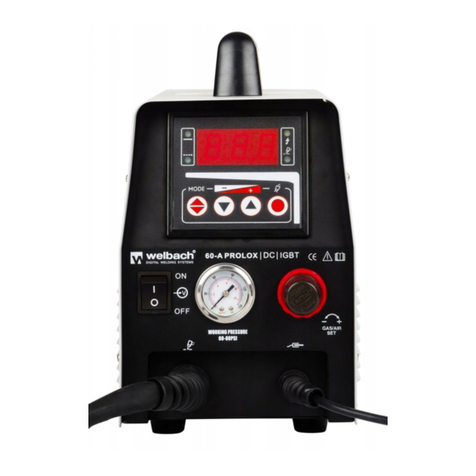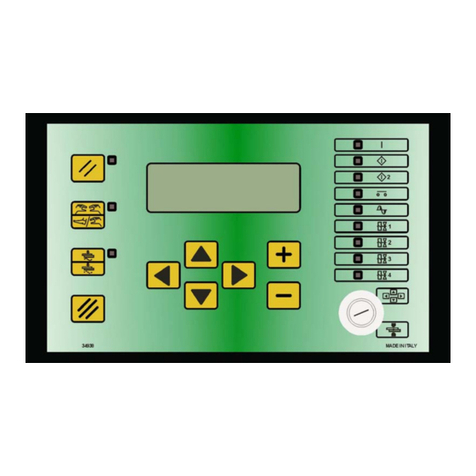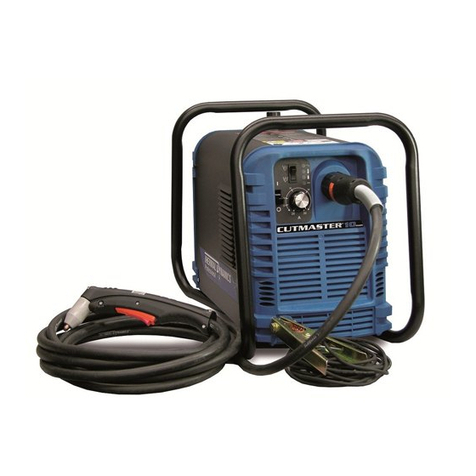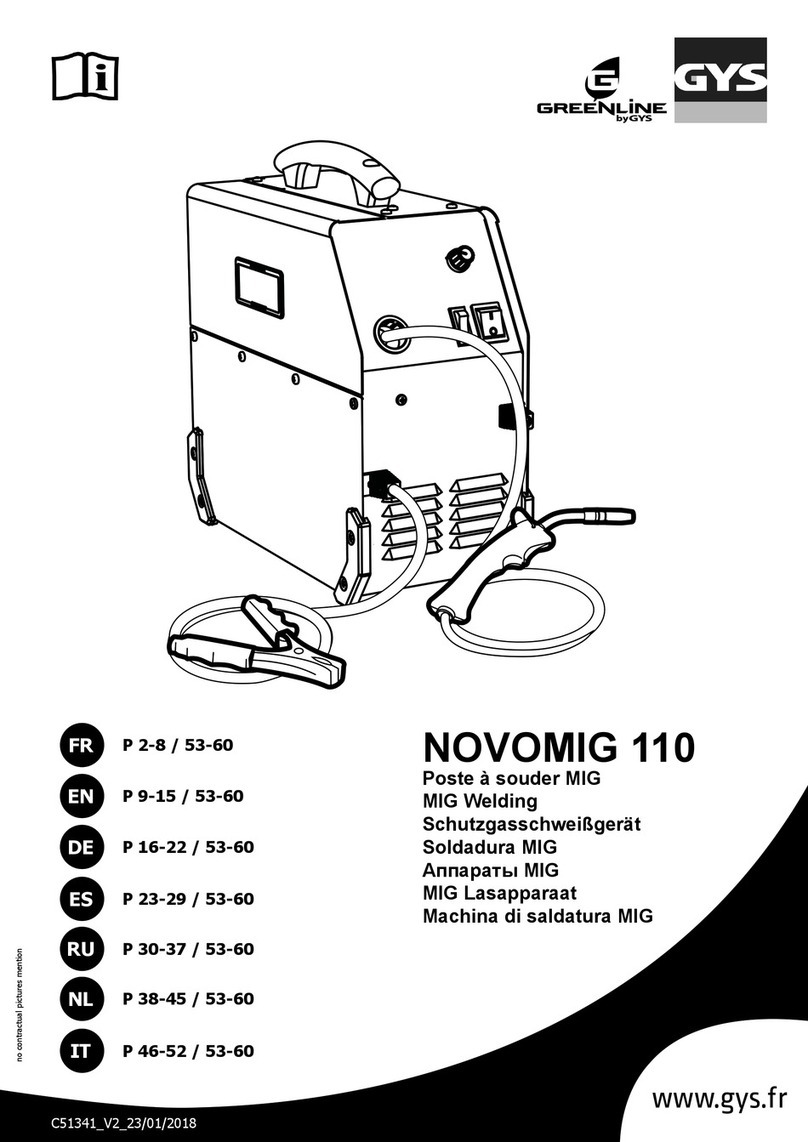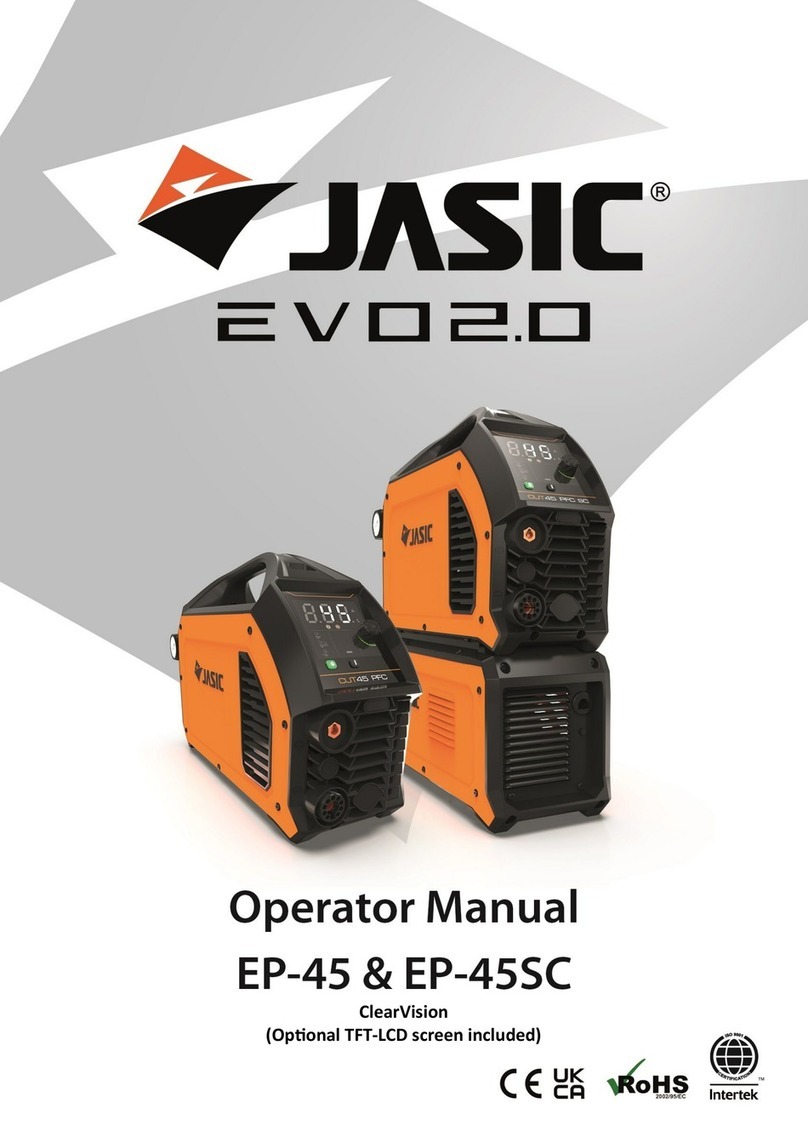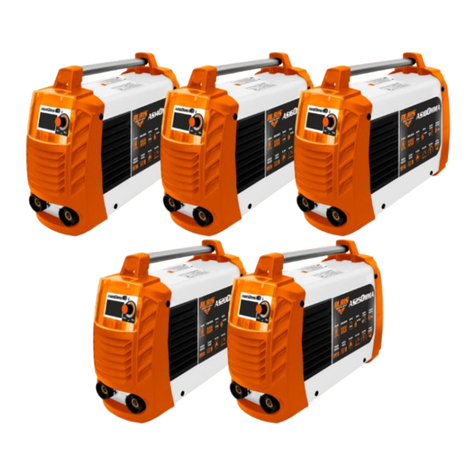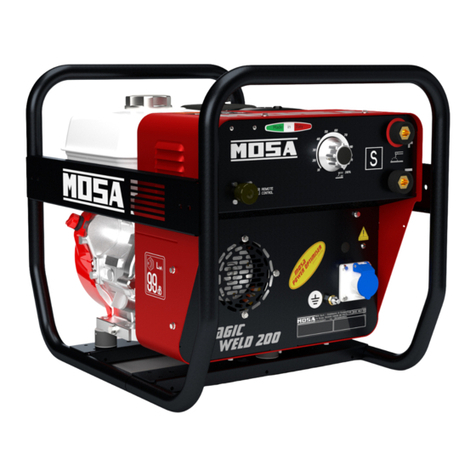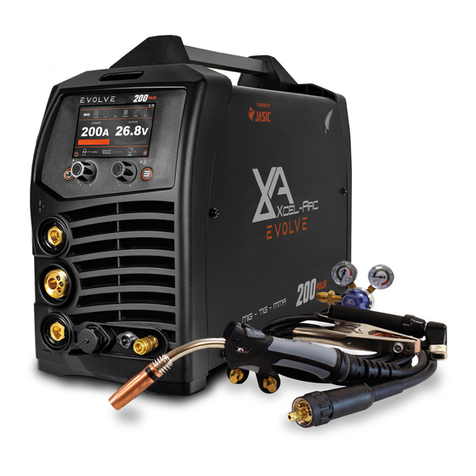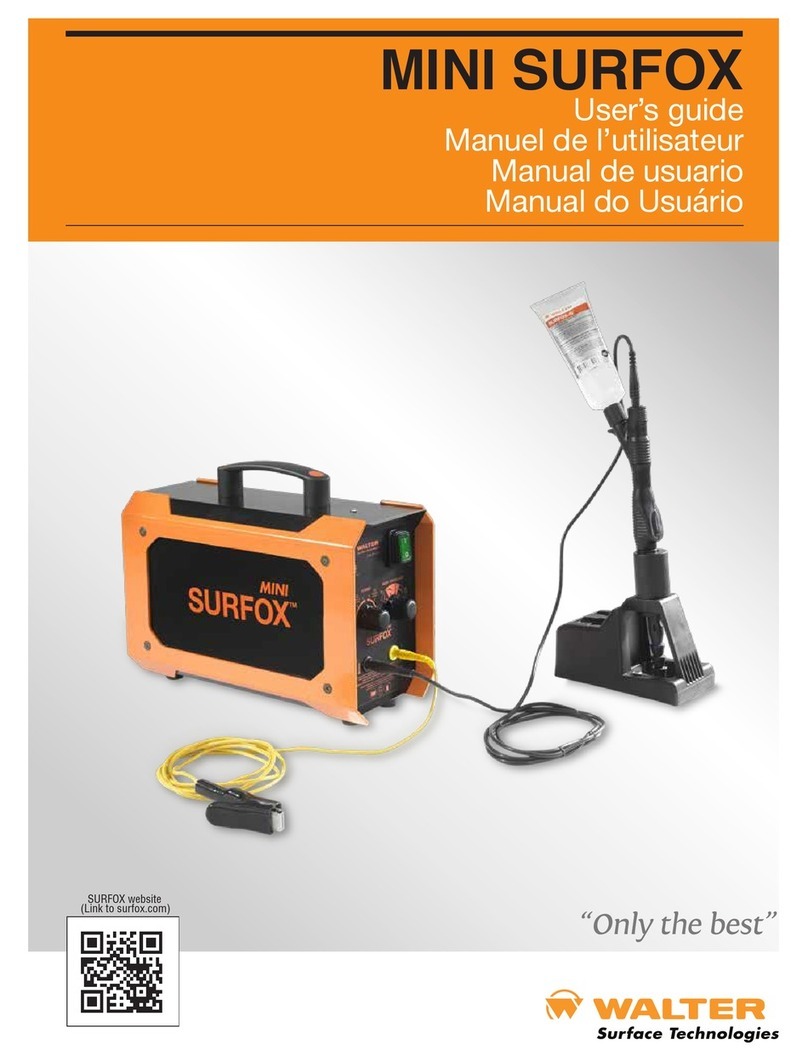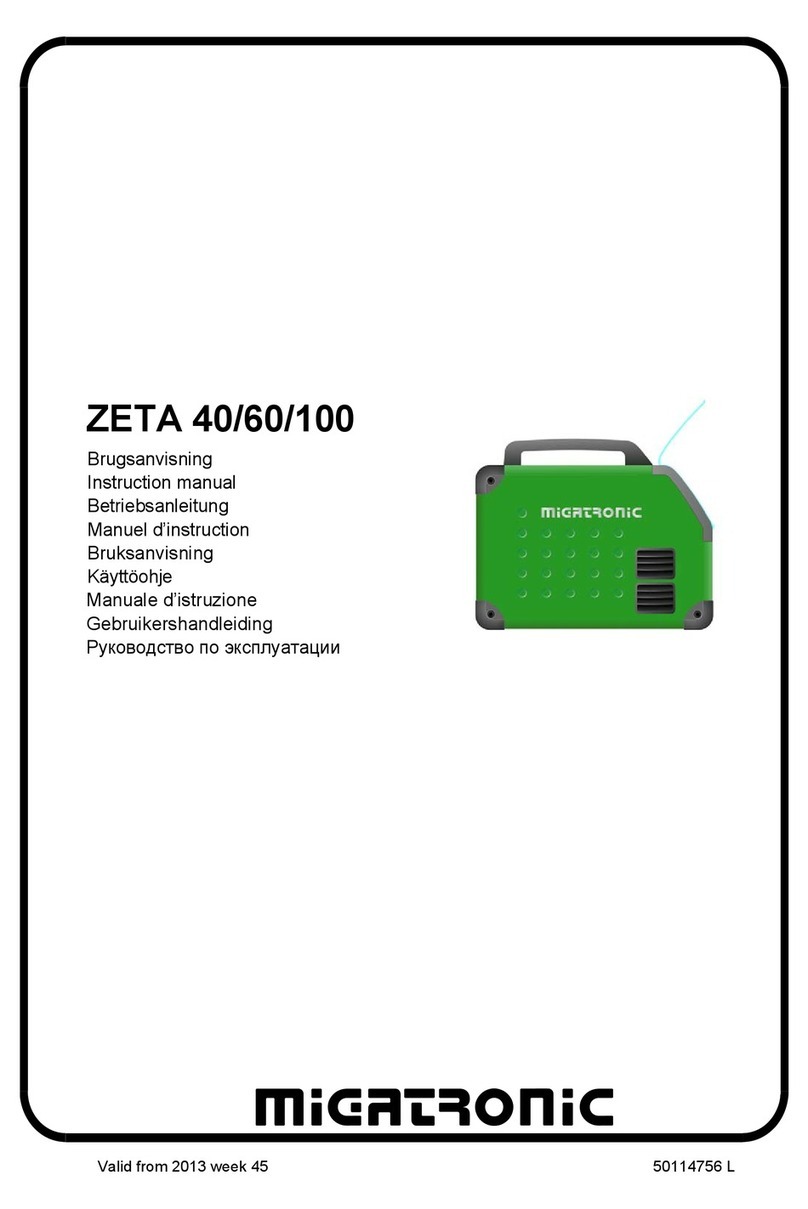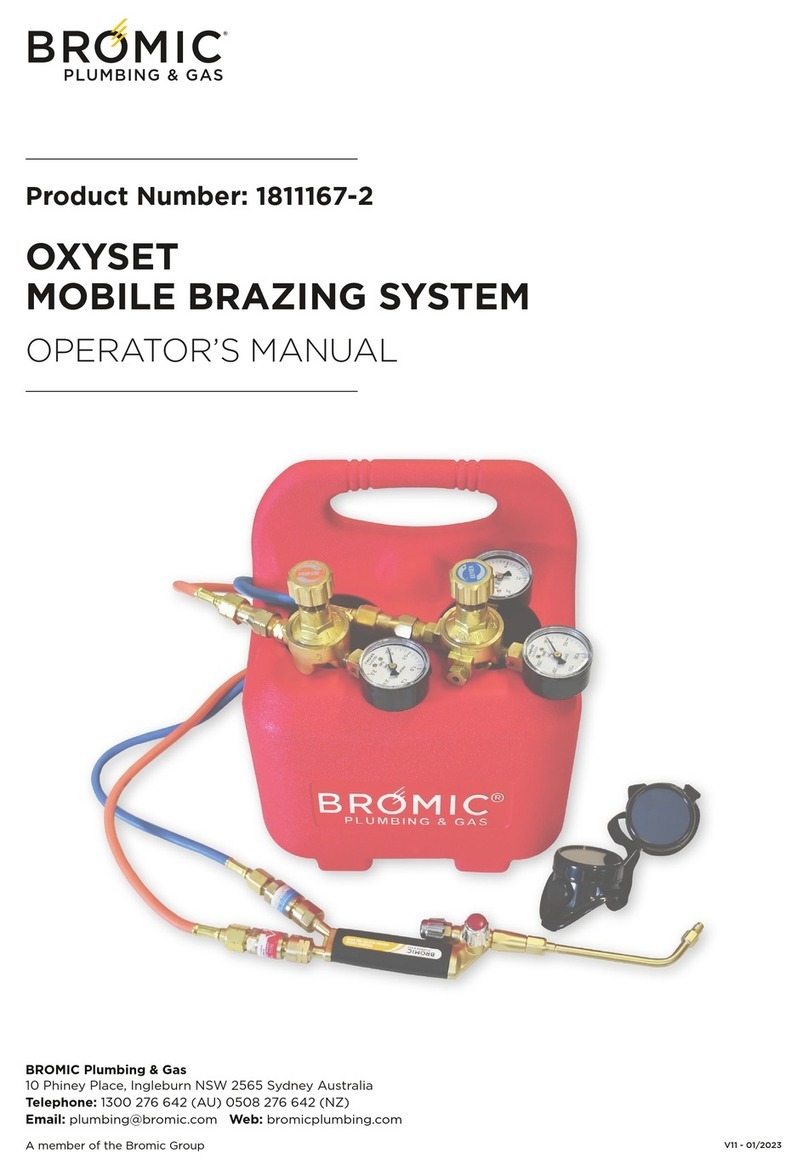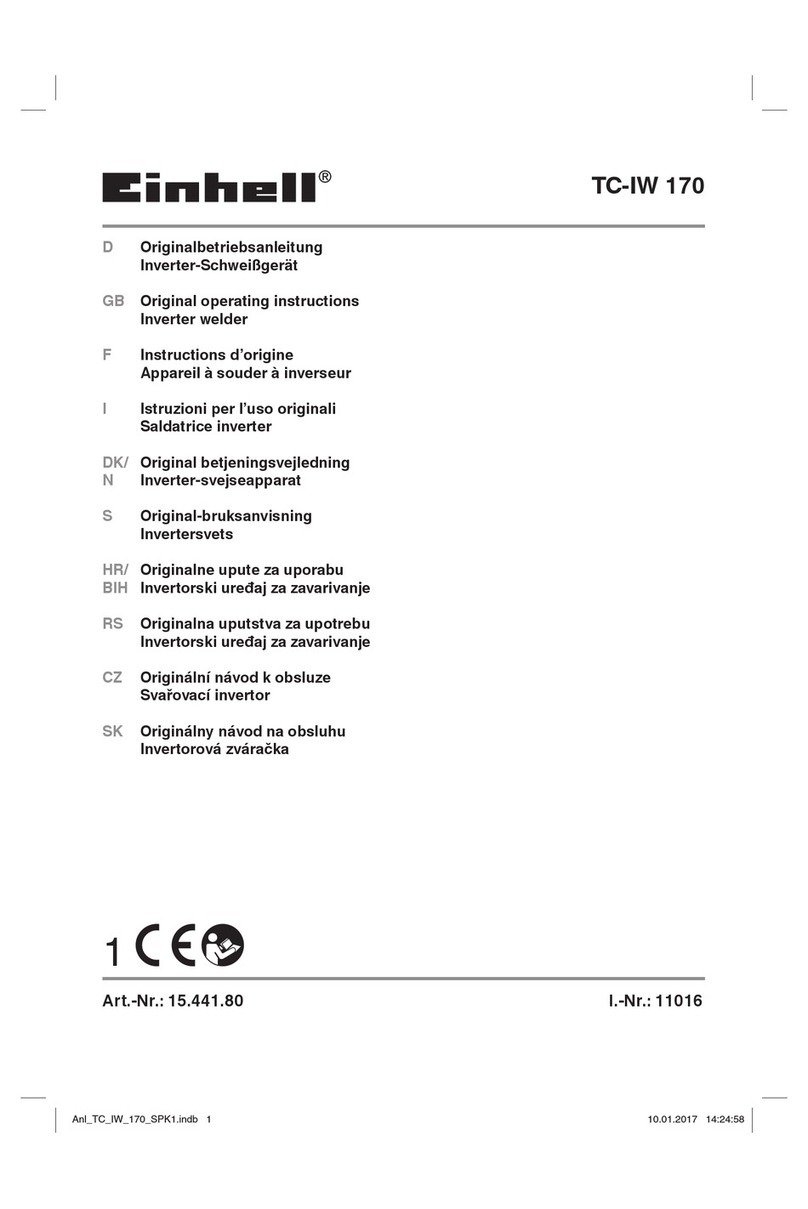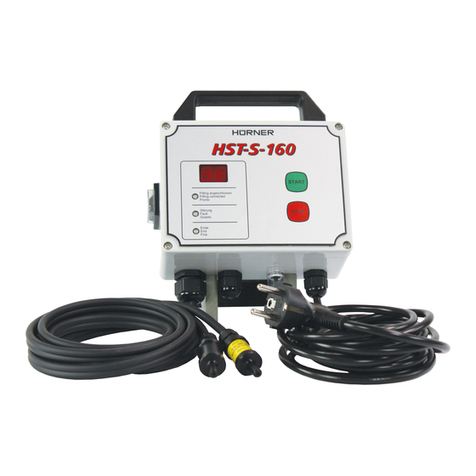Elektron KERCOMET 170 User manual

Made in Germany
Operation Manual
KERCOMET 170 and 210
MULTIMIG 150
MIG / MAG - Welding ma hine
Item-No: 327 972
Revision: 1.0 - Original
Version:
31.01.2013
Be sure you have read and understood this operating
manual before you arry out any works on and/or with this
equipment!

2
© litzRotary GmbH
ranch remen
Hinterm Sielhof 22
D-28277 remen
Germany
Phone: +49 (0)421 / 54 90 6 - 906
Fax: +49 (0)421 / 54 90 6 - 19
E-Mail: [email protected]
Internet: www.elektron-bremen.de
Release:
litzRotary GmbH ranch remen

KERCOMET 170
und
210, MULTIMIG 150
Table of ontents
3
Table of ontents
1
Ma hine elements 4
2
Explanation of symbols 5
2.1
Meaning of the symbols in the operation
manual 5
2.2
Meaning of the symbols on the machine 5
3
Safety pre autions 5
4
General regulation of use 6
5
Unit prote tion 6
6
Noise emission 6
7
Ambient onditions 7
8
UVV inspe tion 7
9
Ele tromagneti ompatibility
(EMC) 7
10
Setup and transport 8
11
Brief operating instru tions 9
12
Before start-up 10
12.1
Connecting the torch 10
12.2
Connecting the ground cable 10
12.3
Select mains voltage 10
12.4
Fastening the ground clamp 10
12.5
Insert the welding wire spool 11
12.6
Thread the wire electrode in 11
12.7
Connecting the inert gas cylinder 12
12.8
Changing the wire electrode 14
13
Start-up 16
13.1
Control console KERCOMET 170 and
MULTIMIG 150 16
13.2
Control console KERCOMET 210 18
13.3
Current/voltage display 19
13.4
Characteristic connection 20
13.5
Main parameters 21
13.6
Secondary parameters 21
13.7
Special functions 22
13.8
Reset setting 22
14
Messages 23
15
Troubleshooting 24
16
Repair and maintenan e 26
16.1
Check regularly 26
16.2
Torch care 26
17
Te hni al data 27
18
Options and a essories 28
18.1
Torch holder 28
19
Disposal 28
20
Servi e 28
21
S hemati KERCOMET 170 29
22
S hemati KERCOMET 210 30
23
S hemati MULTIMIG 150 31

KERCOMET 170
and
210, MULTIMIG 150
Ma hine elements
4
1 Ma hine elements
Fig. 1: Machine elements
1 Safety chain for gas
2 Hoisting points
3 Mains cable
4 Mains voltage changeover-switch
(on switch able units only)
5 Gas hose
6 Tray area
7 Handle
8 Control panel
9 Main switch
10 Socket for ground cable
11 Central socket
Some depicted or described acces-
sories are not included in the
scope of delivery.
Subject to change.

KERCOMET 170
and
210, MULTIMIG 150
Explantion of symbols – Safety pre autions
5
2 Explanation of symbols
2.1 Meaning of the symbols in the
operation manual
Danger to life and limb!
If the danger warnings are disre-
garded, this can cause slight or
severe injuries or even death.
Danger of property damage!
Disregarding danger warnings can
cause damage to w
ork pieces,
tools, and equipment.
General note!
Designates useful information
about the product and equipment.
2.2 Meaning of the symbols on the
ma hine
Danger!
Read the user information in the
operation manual.
Dis onne t the mains plug!
Pull out th
e mains plug before
opening the housing.
3 Safety pre autions
Hazard-free working with the ma-
chine is only possible if you read
the operating and safety instruc-
tions completely and strictly ob-
serve them.
Please obtain practical training be-
fore u
sing the machine for the first
time. Follow the accident preven-
tion regulations (UVV
1
)).
efore starting any welding work,
clear away any solvents,
degreasing agents, and other
flammable materials from the
working area. Cover flammable
materials wh
ich can not be moved.
Only weld if the ambient air
contains no high con
centrations of
dust, acid vapours, gases or
flammable substances. Special
care must be taken during repair
work on pipe systems and tanks
which contain or have con
tained
flammable liquids or gases.
Never touch live parts inside or
outside of the housing. Never touch
welding electrodes or live welding
current parts in a machine that is
on.
Do not expose the machine to rain,
do not spray water on it or steam
blast it.
Always use
a welding shield. Warn
other persons in the welding area
about arc-rays.
1
) Only for Germany.
Available at Carl Heymanns-Verlag,
Luxemburger Str. 9, 50939 Köln.

KERCOMET 170
and
210, MULTIMIG 150
General regulation of use
6
Please use a suitable extrac
tion
system for gases and cutting
fumes. Always wear breathing ap-
paratus whenever there is a risk of
inhaling welding or cutting vapours.
If the mains cable is damaged or
severed in use, do not touch the
cable but unplug the mains plug
immediately. Never use a machine
if the mains cable is damaged.
Keep a fire extinguisher near the
welding area.
Check the welding area for fire af
ter
welding (see UVV
1
)).
Never try to disassemble the pres-
sure reducer. Replace the defec
tive
one.
The machine must be transported
or set up only on firm, leve
l
surfaces. The maximum admissible
angle of inclination for setting up or
transporting is 10°.
Service and repair work may only be carried
out by a trained electrician.
Ensure that the ground cable has good and
direct contact near the welding location. Do
not allow welding current to pass through
chains, ball bearings, steel cables or
grounding equipment; this may melt them.
Secure yourself and the welding machine
when working in elevated or inclined areas.
The machine may only be connected to a
properly grounded mains supply. (Three-
phase four-wire system with grounded
neutral conductor or single phase-three-wire
system with grounded neutral conductor)
socket and extension cable must have a
functional protective conductor.
Wear correct protective clothing, leather
gloves and leather apron.
Protect the welding area with curtains or
mobile screens.
Do not use this machine to thaw frozen
water pipes or cables.
In closed containers, under cramped con-
ditions, and in high electrical risk areas, only
use machines with the S sign.
Switch off the machine during breaks and
close the valve of the gas cylinder.
Secure the gas cylinder with a chain to
prevent it falling over.
Disconnect the mains plug from the mains
before changing the place of installation or
making repairs to the machine.
Please heed the safety regulations which apply
to your country.
Subject to change.
4 General regulation of use
This unit is for welding of steel, aluminium and
their alloys as well as for brazing with CuSi
wires for commercial as well as for industrial
use.
5 Unit prote tion
This machine is protected electronically
against overloading. Do not use fuses of higher
amperage than printed on the identification
plate.
Close the side cover before starting any
welding work.
6 Noise emission
The noise level of the unit is less than
70 d (A), measured under standard load in ac-
cordance with EN 60974-1 in the maximum
working point.

KERCOMET 170
und
210, MULTIMIG 150
Ele tromagneti ompatibility (EMC)
7
7 Ambient onditions
Temperature range of ambient air:
In operation:
-10 °C … +40 °C (+14 °F … +104 °F)
Transport and storage:
-25 °C … +55 °C (-13 °F … +131 °F)
Relative humidity:
up to 50 % at 40 °C (104 °F)
up to 90 % at 20 °C (68 °F)
Operation, storage and transport
may only be carries out within the
ranges indicated! Use outside of
this range is c
onsidered not used
with its intended purpose. The
manufacturer is not liable for dam-
ages cause by misuse.
Ambient air must be free of dust, acids, cor-
rosive gases or other damaging substances!
8 UVV inspe tion
Operators of commercially-operated welding
systems are obliged to have safety inspections
of the equipment carried out regularly in
accordance with VDE 0544-4. ELEKTRON
recommends inspection intervals of 12 months.
A safety inspection must also be carried out
after alterations or repair of the system.
Improper UVV inspections can
destroy the system
9 Ele tromagneti ompatibility
(EMC)
This product is manufactured in conformance
with the current EMC standard. Please note
the following:
The machine is intended for welding in both
commercial and industrial applications
(CISPR 11 class A). Use in other
surroundings (for example in residential
areas) may disturb other electronic devices.
Electromagnetic problems during start-up
can arise in:
• Mains cables, control cables, signal and
telecommunication lines near the welding or
cutting area
• TVs / radios
• Computers and other control equipment
• Protection equipment such as alarm
systems
• Pacemakers and hearing aids
• Equipment for measurement and calibration
• Equipment with too little protection against
disturbances
If other equipment is disturbed it may be
necessary to provide additional shielding.
The affected area can be bigger than your
premises/property. This depends on the
building, etc.
Please use the machine in compliance with the
manufacturer's instructions. The machine
operator is responsible for installation and use
of the machine. Furthermore, the owner is
responsible for eliminating the disturbances
caused by electromagnetic fields.

KERCOMET 170
und
210, MULTIMIG 150
Setup and transport
8
10 Setup and transport
Danger of injury du
e to the de
-
vi e falling over and rashing!
When transporting using mechani-
cal lifting equipment (e.g. crane,
etc.), only the hoisting points shown
here may be used. Use suitable
load-carrying equipment.
Each lifting point must be loaded
separately. Do NOT,
for example
put one load strap through both
handles, as this could lead them to
be pulled together and cause
breakage!
Do not use a fork-lift truck or simi
lar
device to lift the machine by its
housing.
Remove the gas cylinder from the
welding machine before transpor-
tation .
The machine must be transported
or set up only on firm, level sur-
faces. The maximum admissible
angle of inclination for setting up or
transporting is 10°.
Fig. 2: Lifting point for 4-point hoisting

KERCOMET 170
and
210, MULTIMIG 150
Brief operating instru tions
9
11 Brief operating instru tions
A detailed description can be found
in chapter. „ efore start up“
Page 10
and chapter. „Start up“
Page 16.
Place the inert gas cylinder on the unit and
secure it with the chain 1.
Remove the screw cap from the inert gas
cylinder and open the valve 32 briefly (blow-
out).
Connect the pressure reducer 13 to the inert
gas cylinder.
Connect the insert gas hose 5 from the unit
to the pressure reducer and open the
cylinder valve.
Insert the mains plug in the socket.
Connect welding return cable to connector
10 and the clamp to the work piece.
Insert wire feed rollers 25 into wire feed unit
in accordance with the type of welding wire
selected, set contact pressure to 2.
Connect the torch to central connector 11
and insert the relevant contact tip to se-
lected welding wire.
Insert welding wire.
Keep torch switch pressed and set main
switch 9 ON. Magnetic valve will be ac-
tivated!
Adjust gas quantity at pressure reducer.
(Rule: wire diameter x 10 = gas quantity).
Hold down the wire feed switch 29 until the
welding Wire projects from the torch neck to
the gas nozzle by approx. 10 mm.
Set required material-wire-gas combination
using characteristic line switch 65.
Select the 2-stroke mode using the button
60.
Select the thickness of material to be
welded using step switch 57.
Torch switch pressed and held = welding.
Release the torch switch = welding process
completed.

KERCOMET 170
and
210, MULTIMIG 150
Before start-up
10
12 Before start-up
12.1 Conne ting the tor h
Connect the central connector 17 of the
torch to the central socket 11.
Fig. 3: Connecting the torch
12.2 Conne ting the ground able
Connect welding return cable 18 to con-
nector 10 and secure it by turning it clock-
wise.
Fig. 4: Connecting the ground cable
12.3 Sele t mains voltage
(Only for machines with mains voltage switch-
over, refer to technical data)
Set the required voltage by using mains
voltage switch 4.
For 230 V operation, the adapter CEE 16 on
shock proof plug (incl. in delivery) may be
used.
Performance values are lim
ited in
230
V mode, i.e. max welding
power is limited to 2/3 of the values
stated in technical data.
12.4 Fastening the ground lamp
Fig. 5: Correct
Attach the ground clamp immediately be-
side the welding point so that the welding
current will not try to find its own return path
through machine parts, ball bearings or
electric circuits.
Connect the ground clamp firmly to the
welding bench or the work piece.
Fig. : Incorrect
Do not place the ground clamp on the
welding machine or the gas cylinder; oth-
erwise the welding current will be carried via
the protective conductors and it will destroy
these.

KERCOMET 170
and
210, MULTIMIG 150
Before start-up
11
12.5 Insert the welding wire spool
Danger to life and limb and fire
hazard due to glowing welding
wire or parts!
Wire excess length of the wire
spool can
cause short circuits with
the side panel or bottom of the unit.
When inserting the welding wire
spool, please pay attention to the
correct winding and make sure that
there are no wire excess lengths.
Set the wire brake in such a way
that the wire spool doesn't con
tinue
running when pressing the torch
key.
Open side panel and turn the retaining nut
20 off from the wire spool holder 22.
Place the welding wire reel on the decoiler
mandrel and ensure that the carrier mandrel
23 locks in position.
For small welding wire reels, use an adaptor
(order number 420 922).
Set the wire brake 21 so that, when the
torch switch is released, the welding wire
spool just does not run on.
Fig. 7: Decoiler mandrel
12.6 Thread the wire ele trode in
Unscrew the contact tip of the torch.
Open side panel.
The diameter of the wire electrode must
agree with the legible embossed figure on
the wire feed rollers 25.
Swing the tilt levers 27 to the side and
thread the wire electrode through the inlet
nozzle 26 and central socket 11.
Fig. 8: open 2-roll wire feed
Fig. 9: open 4-roll wire feed
Swing the lever back 28 and secure in po-
sition with the tilt levers 27.

KERCOMET 170
and
210, MULTIMIG 150
Before start-up
12
Fig. 10: close 2-roll feed
Fig. 11: close 4-roll feed
Turn on the machine at mains switch 9.
Fig. 12: Wire feed button
Press wire feed button 29.
Adjust the contact pressure using the reg-
ulation screws 27 so that wire feed rollers
25 just slip when the welding wire spool is
stopped. The wire must not be jammed or
deformed.
A B C
Correct Contact pressure
too high
Wrong wire feed
roller
Fig. 13: Wire feed rollers
Note for wire feed unit with 4 rollers:
Adjust the contact pressure of the wire feed
rollers 25 on the side of the inlet nozzle 26
to be less than on the side of the central
socket 11 in order to keep the wire
electrode under tension in the wire feed
unit.
Push the wire feed button 29 until the wire
protrudes from the torch neck by about 20
mm.
Screw the contact tip matching the wire
thickness into the torch and cut off the
protruding end of the wire.
12.7 Conne ting the inert gas ylinder
Set the insert gas cylinder 14 down on the
carrier plate and secure it with the chain 1.
riefly open the gas cylinder valve 32
several times in order to blow out any dirt
particles present.
Connect the pressure reducer 13 to the inert
gas cylinder 14.
Screw the inert gas hose 5 to the pressure
reducer.
Open valve 32 of shielding gas bottle 14.
Turn the machine off at main switch 9.
Press torch key and keep it pressed.
Turn on the machine at mains switch 9.
Solenoid valve will be switched on for 10
seconds.

KERCOMET 170
and
210, MULTIMIG 150
Before start-up
13
Set the gas quantity using adjusting screw
35 of the pressure reducer 13. The gas
quantity will be displayed on the flow meter
34.
Rule of thumb:
Gas volume = wire diameter x 10 l/min.
The cylinder content is indicated on the
content manometer 33.
Fig. 14: Connecting the inert gas cylinder

KERCOMET 170
and
210, MULTIMIG 150
Before start-up
14
12.8 Changing the wire ele trode
Change the wire feed rollers. Select the
most suitable rollers for the application.
Fig. 15: Wire feed rollers
A Steel feed roller
B Aluminium feed roller
C Knurled feed roller (for flux-cored wire)
Fig. 1 : Marking of wire feed rollers
Replace the steel torch with an appropriate
torch, or change the wire feed spiral.
Wire feed spiral: (for steel or flux- ored
wire)
Remove the existing wire feed spiral or
plastic core and insert the new wire feed
spiral. (Refer to the operating manual for the
torch)
Insert the guide tube 85 into the central
connection.
Plasti ore: (for aluminium, stainless steel
or CuSi wire)
Remove the existing wire feed spiral or
plastic core and insert the new plastic core.
(Refer to the operating manual for the torch)
Remove the guide tube 85 from the central
connection.
Shorten the protruding plastic core so that it
is tight up against the wire feed roller, and
slide the appropriately shortened support
tube over the protruding plastic core for
stabilisation.
All:
Tighten the torch and thread the wire elec-
trode in.
The order numbers of the replace-
ment part
s depend upon the type of
torch used and the diameter of the
wire, and can be obtained from the
torch spares lists.

KERCOMET 170
and
210, MULTIMIG 150
Before start-up
15
Fig. 17: Wire feed
7 Central socket
17 Central connection (torch)
25 Wire feed roller
38 Retaining nipple (=clamp) of the plastic
liner for 4.0 mm and 4.7 mm outside
diameter
39 O-ring
40 Union nut
41 Plastic liner
42 Support tube for plastic cores with 4 mm
OD Support tube not required with OD of
4.7 mm.
43 Guide tube
44 Wire feed spiral

KERCOMET 170
and
210, MULTIMIG 150
Start-up
16
13 Start-up
13.1 Control onsole KERCOMET 170 and MULTIMIG 150
Fig. 17: Control console KERCOMET 170 and MULTIMIG 150

KERCOMET 170
and
210, MULTIMIG 150
Start-up
17
45 Symbol wire feed
lights up in the 7-segment display 47 if the
wire feed is displayed in m/min or as
correction value in %.
47 7-segment display wire feed / material
thickness
depending on the mode, wire feed,
material thickness, welding step or (al-
ternating) secondary parameter code and
value are displayed.
49 Symbol 4-stroke
lights up if 4-stroke mode is set.
50 Symbol 2-stroke
lights up if 2-stroke mode is set.
51 Symbol Spot welding
lights up if spot welding mode is set.
52 Symbol Interval
lights up if interval mode is set
53 Symbol material thickness
lights up if the 7-segment display 47
displays the material thickness in mm.
56 Main switch
for turning the welding machine ON and
OFF.
57 Step switch material thickness / welding
step
by setting the step switch, for approx. 2
seconds the material thickness alt. welding
step will be displayed in the 7-segment-
display 47.
58 Symbol 230 V
lights up if 230 V is selected (applicable for
units with voltage changeover switch)
59 Symbol 400 V
lights up if 400 V is selected.
60 Trigger Mode
to select 2-stroke, 4-stroke, spot welding
or interval mode.
61 Turning knob wire feed
for adjustment of wire feed. y activation
of the turning knob, the wire feed will be
displayed as correction value in % on the
7-segment display 47, after setting the
speed will be displayed in m/min.

KERCOMET 170
and
210, MULTIMIG 150
Start-up
18
13.2 Control onsole KERCOMET 210
Fig. 19: Control console KERCOMET 210

KERCOMET 170
and
210, MULTIMIG 150
Start-up
19
45 Symbol wire feed
lights up in the 7-segment display 47 if the
wire feed is displayed in m/min.
46 Symbol welding current
lights up if the 7-segment display 47
displays the welding current in Ampere.
47 7-segment display welding current / wire
feed depending on set mode, either wire
feed, welding current or secondary
parameter value will be displayed.
49 Symbol 4-stroke
lights up if 4-stroke mode is selected.
50 Symbol 2-stroke
lights up if 2-stroke mode is selected
51 Symbol spot-welding
lights up if spot welding mode is selected.
52 Symbol interval
lights up if interval mode is selected.
53 Symbol material thickness Display 55
lights up if the material thickness is
displayed in mm.
54 Symbol welding voltage
lights up if the 7-segment display 55
displays the welding voltage in V.
55 7-Segment display material thickness /
welding voltage
according to set characteristic line (see
chapter characteristic setting) or mode
either the material thickness, welding
voltage or secondary parameter codes will
be displayed.
56 Main switch
for switching the welding unit ON and
OFF.
57 Step switch material thickness / welding
voltage
for adjusting the material thickness alt. the
welding voltage, values will be displayed in
the 7-segment display 55.
58 Symbol 230 V
lights up if 230 V welding voltage is set.
(machines with changeover switch only).
59 Symbol 400 V
lights up if 400 V welding voltage is set.
60 Mode selection key
for setting of mode, either 2-stroke, 4-
stroke, spot welding or interval.
61 Turning knob wire feed for wire feed
adjustment.
y activating the turning knob, the wire
feed is displayed in the 7-segment display
47 as correction value in %, after setting in
speed m/min.
13.3 Current/voltage display
47 Current indicator
55 Voltage display
The actual values of welding voltage and
welding current are displayed during and after
welding. If any changes of the set values by
the operator (i.e. step switch, turning knob,
key) take place, the main parameter wire feed
and material thickness will be displayed.

KERCOMET 170
and
210, MULTIMIG 150
Start-up
20
13.4 Chara teristi onne tion
Fig. 20: Characteristic table and selection knob
The characteristic selection knob 65 and the
corresponding table are in the wire feed
casing.
The table content may differ from
your welding machine. The char-
acterist
ic lines are set individually
for each machine type.
Select the required material-wire-gas
combination from the characteristic table.
Read the corresponding characteristic
number off from the right hand column.
Set the corresponding number from the
table using selection knob 65.
elow the characteristic number 0 (manual
mode)
• Is the material-wire-gas combination
nullified. Wire feed and welding voltage can
be set manually.
• The welding step ( asic Plus) instead of
material thickness will be displayed.
• The must-value for welding voltage (Control
Pro) instead of material thickness will be
displayed.
If an unassigned number is set with
the characteristic selection knob 65,
the 7-segment-
display 47 will
display the error message „noP“.
This manual suits for next models
2
Table of contents
Other Elektron Welding System manuals
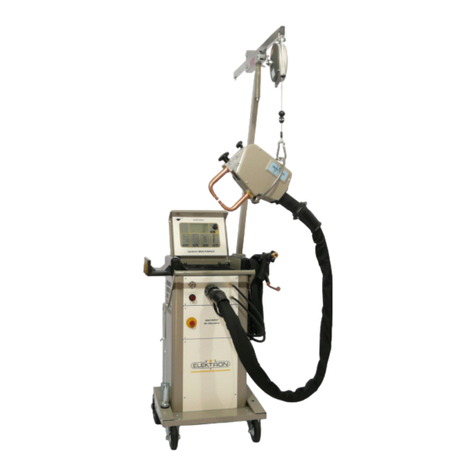
Elektron
Elektron MULTISPOT MI-100control User manual
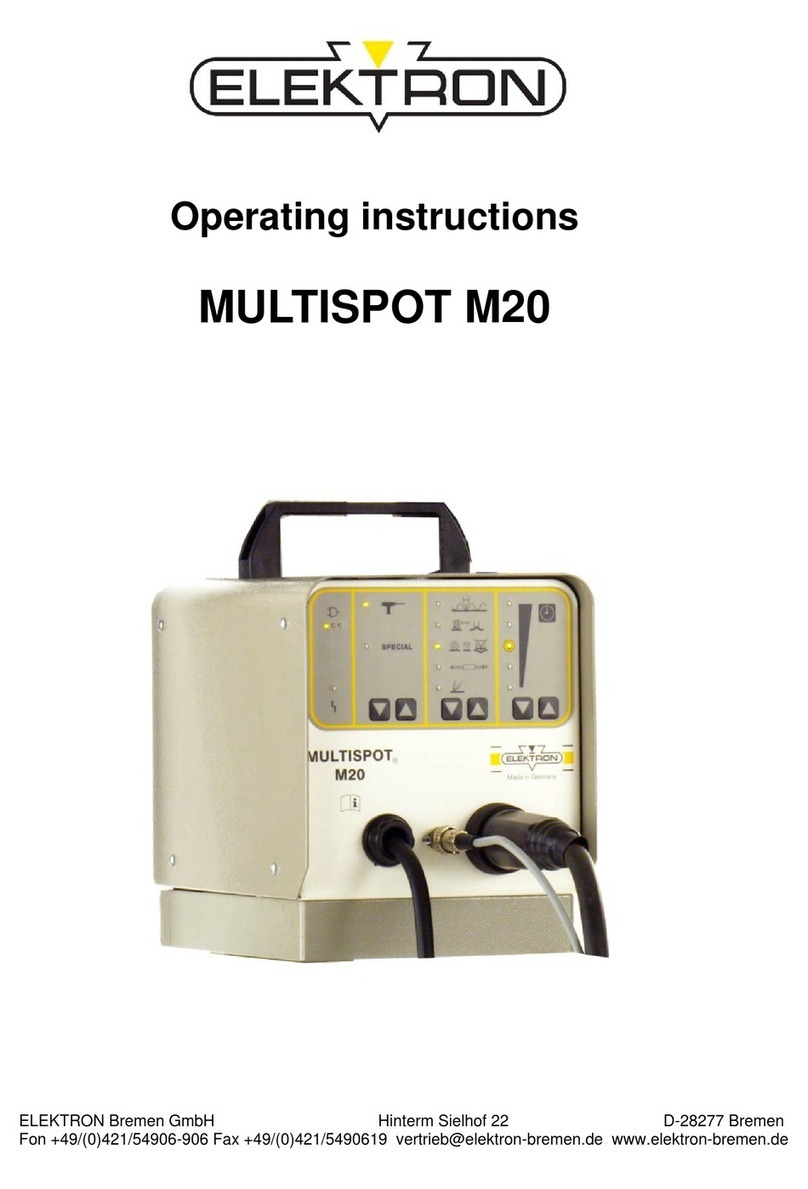
Elektron
Elektron MULTISPOT M20 User manual
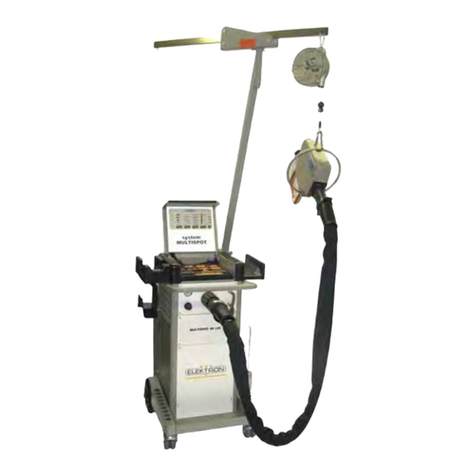
Elektron
Elektron MULTISPOT MI-100 User manual
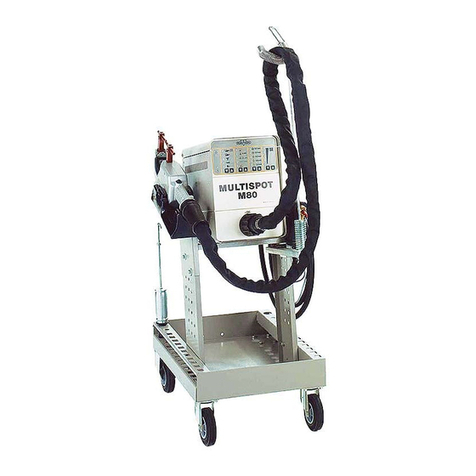
Elektron
Elektron MULTISPOT M80 User manual
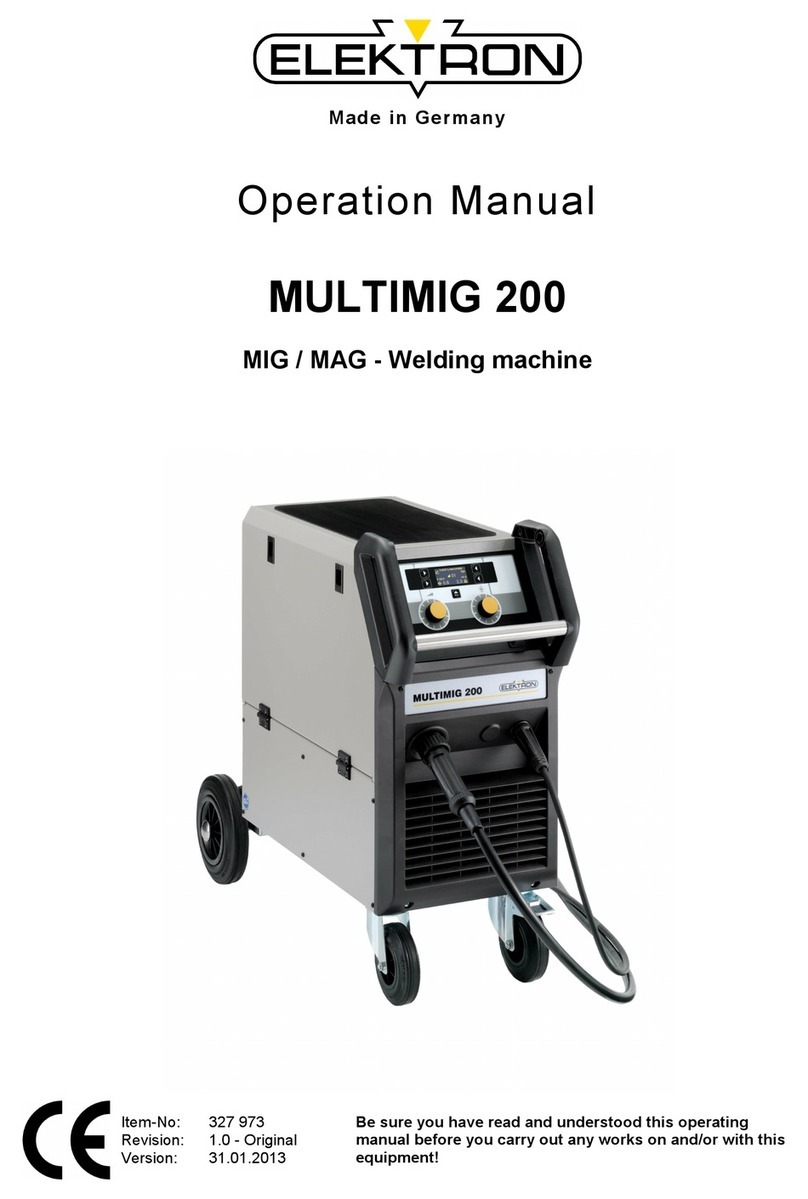
Elektron
Elektron MULTIMIG 200 User manual
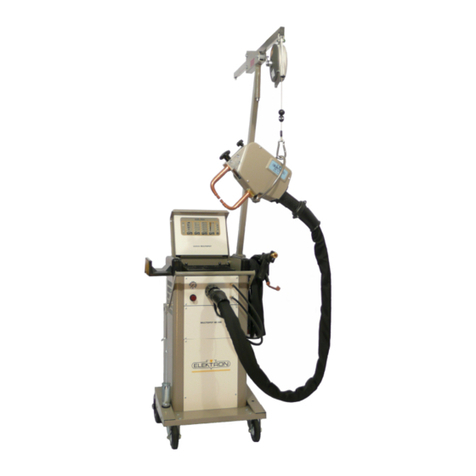
Elektron
Elektron MULTISPOT MI-100-3 User manual

Elektron
Elektron MULTIMIG 400puls User manual
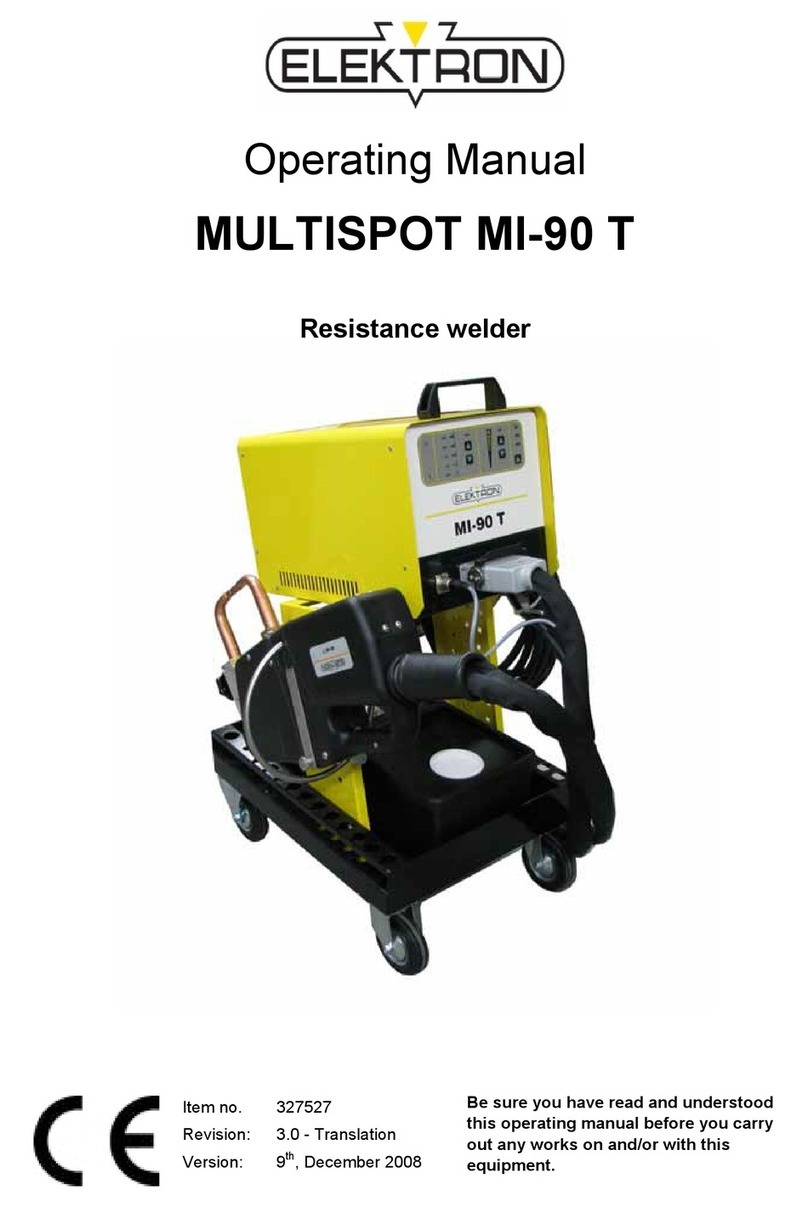
Elektron
Elektron MULTISPOT MI-90 T User manual
